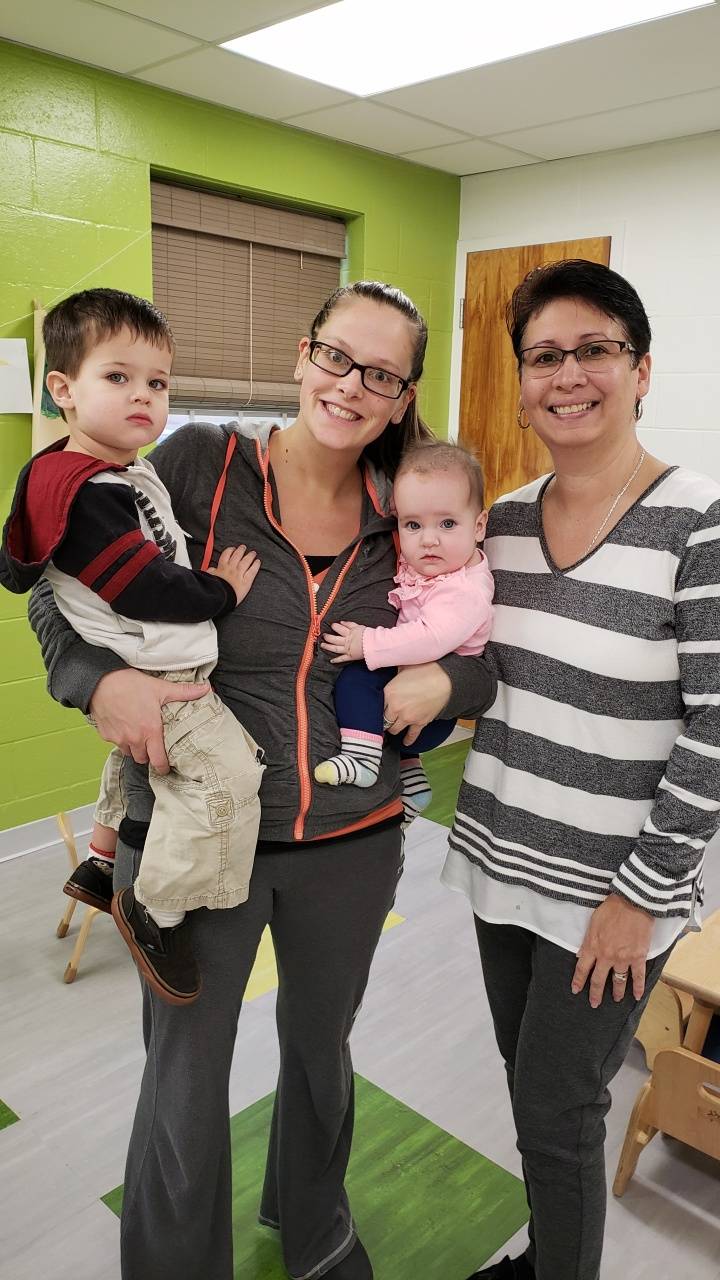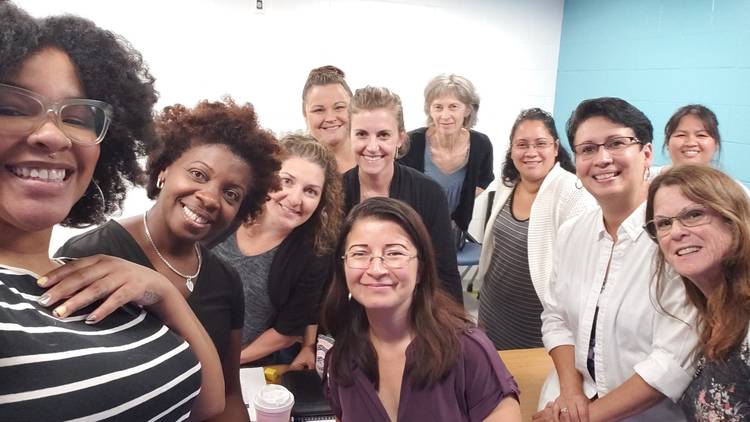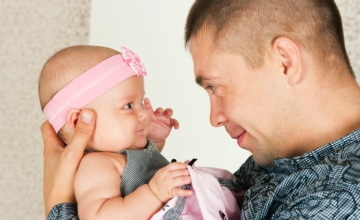Rebecca Cuevas, Area Cooperative Educational Services Middlesex County Early Head Start, Middletown, Connecticut
Grace Whitney, SchoolHouse Connection, Washington, DC

Abstract
This article describes the ongoing impact of one Early Head Start grantee’s participation in a statewide initiative to connect the state’s network of residential substance abuse treatment programs for women and their children with their local Early Head Start program. The initiative was designed to enhance child development and parenting supports using a self-assessment tool; to childproof the residential recovery program; to prevent homelessness by connecting families with ongoing housing supports upon completion of recovery services; to ensure Early Head Start access and participation; and to increase cross-training, collaboration among staff, and overall coordination of services to families.
Since 2009, Area Cooperative Educational Services Middlesex County Early Head Start (ACES EHS) has been providing comprehensive home visiting services to children and families in six Connecticut communities. Investments in early care and education are an investment in a thriving and successful future for children across Connecticut and the nation. ACES EHS emphasizes the role of the parent as the child’s first and most important teacher. It is through relationships that all early development takes place. Along with the support of home visiting staff, ACES EHS’s focus is on the home as the child’s primary learning environment. Recognizing the importance of the parallel process, the relationship of the home visitor to parents, caregivers, and expectant families is central to the program’s effective service delivery. This relationship becomes the vehicle through which to strengthen the parent’s ability to nurture the healthy development of the children.
ACES EHS uses both the evidence-based Early Head Start Homebased Model (U.S. Department of Health and Human Services, 2018) and the evidence-based Parents as Teachers curriculum (Parents as Teachers, n.d.) to provide parent education primarily through home visits and group meetings. ACES EHS uses Parents Interacting With Infants (PIWI, n.d.) in socialization experiences. This model promotes the healthy social–emotional development of infants and toddlers. ACES EHS also uses Creative Curriculum Teaching Strategies GOLD (Teaching Strategies–GOLD: Birth Through Kindergarten (n.d.) to ensure and assess that children are meeting early learning goals and objectives. The number of trauma-impacted families in ACES EHS continues to grow because of an increase in program participants who are, or have been, homeless, as well as those impacted by substance use disorders. This is in part due to ACES EHS’s involvement in the third cohort of statewide outreach initiatives to target these populations for enrollment into EHS and Head Start services. ACES EHS has continued to see an increase in its enrollment of women with substance use disorders who often also have had experiences of sexual abuse, intimate partner violence, homelessness, lack of social supports, inadequate parenting, poor nutrition, and psychiatric comorbidity.
A Collaboration Between EHS and Residential Treatment for Women and Children
ACES EHS’s participation in the statewide targeted outreach initiative from May 2016 to January 2017 was sponsored by the Connecticut Head Start State Collaboration Office which partnered with the Connecticut Department of Mental Health and Substance Abuse Services (DMHAS) to pair each of its women’s residential treatment programs with its local EHS provider. The partnership with DMHAS was the third cohort of local collaborations involving Head Start and EHS grantees and local emergency shelters and residential treatment programs. It was common for women to move from residential recovery into emergency shelters because they had no homes and needed to “become homeless” to qualify for housing supports. Thus, it was important for EHS and women’s residential treatment pro-grams to work more closely together to prevent homelessness and create enduring supports that reinforce the recovery process and also promote healthy child development and strong families once residential treatment services ended.
Goals of the Collaboration
Overall, there were three goals for this community partnership effort: (1) working together to make residential settings more child friendly, (2) enrolling young children into EHS and Head Start programs, and (3) strengthening cross-sector partnerships to align and improve services for families. The initiative offered training and technical assistance to participating staff from EHS/Head Start programs and Women’s Residential Services, and it provided small grants to support purchases that would make residential settings and their services more child-friendly.
Designated lead staff members in each of the EHS/Head Start programs and women’s residential treatment programs worked together as teams to complete the Early Childhood Self-Assessment Tool for Family Shelters (U.S. Department of Health and Human Services, 2015) at the start and end of the initiative. They developed an action plan based on the self-assessment that was then used to guide purchases for the residences and joint activities, and to compile progress reports at the midpoint and end of the project period. They documented the number of children enrolled in EHS and Head Start, their shelter enhancements and collaborative activities, any policy or practice modifications made to better coordinate and align services, and other resultant changes they attributed to the initiative. In Cohort 3, staff members also completed the Network Data-Collection Instrument (Provan, Veazie, Staten, & Teufel-Shone, 2005) and Wilder Collaboration Factors Inventory (Mattessich, Murray-Close, & Monsey, 2001) tools at the start and end of the initiative to measure changes in collaboration.
The results of Cohort 3, which included ACES EHS, were reported in a poster presentation at the ZERO TO THREE Annual Conference 2016 in New Orleans, LA. Notable among the results was evidence that when teams completed the tool together, more gaps in child-focused services were identified. The early childhood team members used the assessment tool to help the members of the residential team to better understand the developmental needs of the children in their care and to know where to obtain items and connect with community resources that could address identified needs.
The Connection's Hallie House for Women and Children
The Connection’s Hallie House for Women and Children, a residential treatment program for expectant mothers and mothers of young children, is one example of how the formal statewide partnership initiative helped to deepen and expand collaboration between EHS and a local residential treatment program. Using the Early Childhood Self-Assessment Tool for Family Shelters (U.S. Department of Health and Human Services, 2015; see Box 1), designated lead staff at ACES EHS and Hallie House worked together as a team to assess practices at Hallie House in the areas of health and safety, wellness and development, workforce standards and training, programming, and food and nutrition. The team created an action plan based on their assessment which then guided their efforts to childproof the environment and Hallie House services. They created a more child- and parenting-friendly setting by creating spaces for parents and children, identifying and incorporating resources for families and staff, and increasing referrals to EHS. As a result, service coordination and family goal setting were dually addressed by both programs. In addition, referrals to ACES EHS became part of the Hallie House program participation policy. ACES EHS was able to provide families with early learning experiences, trainings, resources, and various on-site activities such as infant massage, which, in response to the individual needs of families, have now been offered as both group and individual sessions of infant massage. In some cases, staff learned that some families didn’t participate in the group sessions for fear of being judged. The infant mental health consultant suggested offering individual sessions, and engagement by those families increased.
The Early Childhood Self-Assessment Tool for Family Shelters (U.S. Department of Health and Human Services, 2015) is intended to help shelter staff ensure their facilities are safe and appropriate for the development of young children. It can be used in any residential setting that serves families because most operate using an adult-centric model. The tool addresses five areas:
1. Health and Safety
2. Wellness and Development
3. Workforce Standards and Training
4. Programming
5. Food and Nutrition
During the period of this statewide initiative, ACES EHS was able to develop a collaborative referral process through which case managers and support staff from both ACES EHS and Hallie House increased their knowledge of one another’s programs. Hallie House became familiar with ACES EHS’s eligibility verification, thus decreasing potential enrollment delays. ACES EHS became more familiar with the state’s 211 central intake process linking families with housing services and specific requirements of housing supports, such as supportive housing programs in the catchment area, and the staff at ACES EHS have maintained regular communication with the local housing authorities to ensure that all families who qualify complete the application process and regularly monitor their progress on the waitlist. ACES EHS also learned about the collaborative outreach activities for homeless families through DMHAS and became more familiar with resources specifically addressing domestic violence in the community.
Since the end of the statewide initiative ACES EHS has continued its relationship with each of these community partners and it continues to strengthen collaboration by ensuring all ACES EHS staff, including leadership, are aware of homeless services and housing eligibility criteria. The leadership has taken a hands-on approach with the housing application process and holds regular collaborative meetings to ensure families and staff receive ongoing guidance. ACES EHS made changes in 2017 to their selection criteria to consider the unique needs of families that are experiencing housing issues. In addition, the director of housing development became a member of the ACES EHS Policy Council. Although Connecticut reported a decrease in the number of homeless families, ACES EHS has seen a significant spike in those families that fit the McKinney-Vento definition (see Box 2) of homeless in their catchment area.
The term “homeless children and youth”
(A) means individuals who lack a fixed, regular, and adequate nighttime residence and includes
(i) children and youths who are sharing the housing of other persons due to loss of housing, economic hardship, or a similar reason; are living in motels, hotels, trailer parks, or camping grounds due to the lack of alternative adequate accommodations; are living in emergency or transitional shelters; or are abandoned in hospitals;
(ii) children and youths who have a primary nighttime residence that is a public or private place not designed for or ordinarily used as a regular sleeping accommodation for human beings;
(iii) children and youths who are living in cars, parks, public spaces, abandoned buildings, substandard housing, bus or train stations, or similar settings; and
(iv) migratory children who qualify as homeless for the purposes of this part because the children are living in circumstances described in clauses (i) through (iii).
Source: 42 U.S. Code § 11434a (2)
The 2018 program information report revealed the highest number of homeless families since opening its doors a decade ago. There were 31 families deemed homeless for the program year out of a total program capacity for serving 98 families. The majority of those families have come to ACES EHS as a result of referrals from Hallie House.

Christie Arnold, vice chair of the Policy Council for Area Cooperative Educational Services Middlesex County Early Head Start, and her two children enrolled in the program, with Rebecca Cuevas, program coordinator. The parent voice and shared decision making is an essential piece of the Early Head Start experience. Photo courtesy of Rebecca Cuevas
Innovative Services
As mentioned previously, this targeted partnership initiative resulted in a number of innovative services for families through ACES EHS. Infant massage was one example a unique opportunity introduced to families at ACES EHS. Facilitated by the ACES EHS infant mental health consultant, these sessions are intended to help parents get to know and understand their child in new ways, to bond and relax together, and to encourage overall well-being. Another innovative opportunity introduced for families was the Lullaby Project, a unique collaboration with the music department at Weslyan University to foster closer relationships both in the community and in families (Carnegie Hall, n.d.). Through the Lullaby Project, ACES EHS expectant families can create personal lullabies to sing to their newborns. One goal of the Lullaby Project is to invite more families residing in shelters and to address the barriers preventing participation in overall program activities. The Lullaby Project has the potential to be introduced to other community partners that work closely with ACES EHS.
Positive Impacts of Collaboration
These opportunities have been offered in different settings and components within ACES EHS and have increased staff knowledge around child development, attachment, engaging differently with clients, and supporting the parent–child dyad in an effort to improve child and family outcomes. As illustrated by the stronger relationship between Hallie House and ACES EHS, community partnerships play a significant role in helping families. These important partnerships are central to the coordination of services while in the program but are just as important with the transitions out of the individual programs and from one program to another. It is program policy for all ACES EHS staff to work toward a plan of transition with families 6 months prior to completing EHS services. ACES EHS staff begins talking with parents in recovery about transitioning out of residential treatment based on their projected date of exit from the residential facility. Transition planning is important because a critical need among mutually served and shared families is housing. However, this planning had not been policy in the past. A major reason for the statewide initiative was that families often completed the recovery program only to be discharged into an emergency shelter because they had nowhere else to go. Families in recovery need a higher level of service coordination and support in gaining safe and affordable housing. When providers and families work together from early in the recovery process, families not only can move to safe and stable housing but they also report feeling already fully engaged in a supportive program that can continue to promote recovery as it promotes strong family relationships, healthy parenting practices, and optimal child development.
The comprehensive services model used by ACES EHS and its family partnership process elevate the focus of services and supports on what parents and caregivers need to feel successful. Since ACES EHS opened its doors in the community, Middlesex Health has been one of its highest sources of referrals because of the program’s positive impact on families and on the community. Mary Doyle, a perinatal social worker at Middlesex Health, stated
EHS meets parents where they are and makes efforts to understand what they are going through. Working collaboratively with community providers can lead to early recognition of the family’s priorities. Many families experience immense isolation, fear judgement, and wish for simple direction. It really requires careful listening which helps to create a more meaningful family goal-setting process. The formulation of realistic action steps can lead families to successful attainment of housing, child care, food, and health care.
The Connection’s Hallie House values the partnership they have strengthened with ACES EHS. Through the same state-wide initiative’s Cohort 3, The Connection also partnered its Mother’s Retreat residential program in Groton with the Thames Valley Council for Community Action’s EHS/Head Start program. Staff at The Connection identified a barrier to aligning their efforts with EHS:
Work needs to be done to align the different definitions of homelessness across agencies. Early Head Start/Head Start programs can prioritize families using the McKinney-Vento Act definition of homelessness, as specified in the Head Start Act and Head Start Program Performance Standards.This enables Early Head Start/Head Start programs staff to coordinate services and complete necessary paperwork to determine a family’s eligibility as homeless while other agencies find they are not allowed to use the same eligibility criteria. One clear example of this lack of alignment is when seeking resources for homeless individuals and completing housing applications, which use a different definition of homelessness and require different eligibility criteria and documentation. This hinders the process for families to secure housing vouchers and other housing supports and hinders some providers from working together to access needed services for families.—Sherrie Weaver, program director, The Connection’s Women and Children Substance Abuse Treatment Programs
Looking to the Future
ACES EHS has seen an increased rate of turnover in the last 2 years with families who wish to stay in the program finding it difficult to gain the financial means to remain in the community. ACES EHS is committed to working with shelters and community providers on how to support families in their effort to stay in the area. When there are little to no familial supports or social networks, families leave the area within 6 months. Affordable housing and child care are major reasons that families relocate outside of the service area. ACES EHS would like to build capacity in the community to help families remain in EHS and in the community by strengthening its own networks with its partners.
ACES EHS would also like to strengthen its organizational structure to include trauma-informed care. The goal is to expand the program to include infant–toddler center-based care with staff that have experience in trauma-informed care. ACES EHS has long provided services with a strong mental health component, and ACES EHS staff have sought formal credentialing with The Endorsement for Culturally Sensitive, Relationship-Focused Practice Promoting Infant Mental Health (IMH-E®; Michigan Association for Infant Mental Health, 2019) through the Connecticut Association of Infant Mental Health to bring quality support and experiences into homes with the goal of promoting the importance of relationship-based practice and healthy attachment. Of note is that, as a result of the partnership, staff of women’s residential recovery programs are now attending training in infant mental health and several are working toward endorsement.
Learn More
Area Cooperative Educational Services (ACES) is a Regional Educational Service Center dedicated to serving communities with an array of services and programs. These include Early Head Start, adult and vocational programs, inter-district educational programs, Open and Magnet School Parent Choice programs, Minority Teacher Recruitment initiatives, behavior services for individuals on the autism spectrum, occupational/physical therapy, professional development, and technology services.
The Connection’s Hallie House for Women and Children
www.theconnectioninc.org/about
Authors
Rebecca Cuevas, MSW, LMSW, is the program coordinator for Area Cooperative Educational Services Middlesex County Early Head Start and a social worker with more than 30 years’ experience working with families, early education, and home visiting initiatives in Connecticut. For the past 15 years, she has worked at Area Cooperative Educational Services, with 10 of those in Early Head Start. Born and raised in New Haven CT, she grew up with a strong sense of family and community. She has long believed that parents play an important role in their children’s lives and that families thrive when they feel supported within their communities. She earned her master’s of social work from the University of Connecticut School of Social Work and bachelor’s degree in psychology from Albertus Magnus College. She is a board member of the Connecticut Association of Infant Mental Health and the Connecticut Head Start Association. Rebecca has been a life-long resident of Connecticut and continues to live there with her husband and two children.
Grace Whitney PhD, MPA, IMH-IV, joined SchoolHouse Connection after 20 years as director of Connecticut’s Head Start State Collaboration Office. She is a developmental psychologist and endorsed as an Infant Mental Health Policy Mentor. Dr. Whitney began her career as a preschool teacher in special education and as a home visitor for at-risk families of infants and toddlers, has since held a variety of clinical and administrative positions, and has frequently taught courses in child development and public policy. She’s shared her work with colleagues in Connecticut using the Early Childhood Self-Assessment Tool for Family Shelters at conferences of ZERO TO THREE and the World Congress for Infant Mental Health.
Suggested Citation
Cuevas, R., & Whitney, G. (2019). Better together: An Early Head Start partnership supporting families in recovery experiencing homelessness. ZERO TO THREE Journal, 39(4), 29–34.
References
Carnegie Hall. (n.d.). Lullaby Project. Source
CreativeCurriculum. (2002–2014). TEACHING STRATEGIES, LLC. www.creativecurriculum.net
Mattessich, P., Murray-Close, M., & Monsey, B. (2001). Wilder Collaboration Factors Inventory: Assessing your collaboration’s strengths and weaknesses. St. Paul, MN: Fieldstone Alliance.
Michigan Association for Infant Mental Health. (2019). The Endorsement for Culturally Sensitive, Relationship-Focused Practice Promoting Infant Mental Health (IMH-E®). Source
Parents as Teachers. (n.d.). Evidence-based model. Source
PIWI: Parents Interacting With Infants. (n.d.). Source
Provan, K. G., Veazie, M. A., Staten, L. K., & Teufel-Shone, N. I. (2005). The use of network analysis to strengthen community partnerships. Public Administration Review,65(5), 603–613.
Teaching Strategies – GOLD: Birth Through Kindergarten. (n.d.). Touring guide. Source
U.S. Department of Health and Human Services, Administration for Children and Families. (2015). Early Childhood Self-Assessment Tool for Family Shelters. Source
U.S. Department of Health and Human Services Administration for Children and Families. (2018). HomVEE—Early Head Start–Home-Based Option (EHS-HBO). Source




